Abstract
The Mycobacterium avium complex, only rarely described as an invasive pathogen in humans, has recently been reported to frequently cause disseminated disease in patients with the acquired immune deficiency syndrome. Between February 1981 and February 1984 at Memorial Sloan-Kettering Cancer Center, 30 patients with acquired immune deficiency syndrome, 3 patients with leukemia, and 2 patients with congenital severe combined immunodeficiency syndrome developed disseminated M. avium complex infection. Mycobacteria were often found in multiple sites both antemortem and postmortem. Blood cultures were a reliable method for detecting disseminated infection, and the new lysis blood culture systems provided an efficient technique for determining the number of organisms per milliliter of blood. Acid-fast stains and cultures of fecal specimens were also helpful in diagnosing infection. Most of the mycobacteria were serovar 4 (77%), and most (86%) produced a deep yellow pigment. All isolates were susceptible to standard concentrations of clofazimine, cycloserine, and ansamycin, but tended to be resistant to isoniazid, streptomycin, ethambutol, ethionamide, and rifampin.
Full text
PDF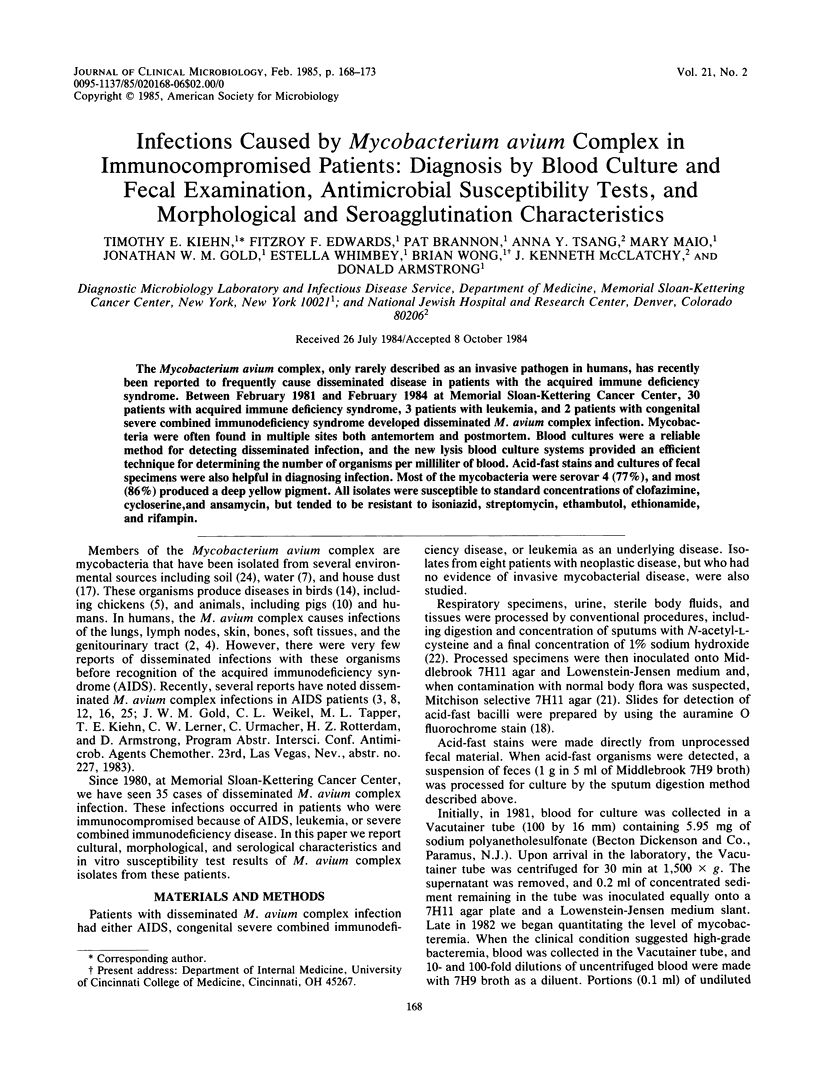
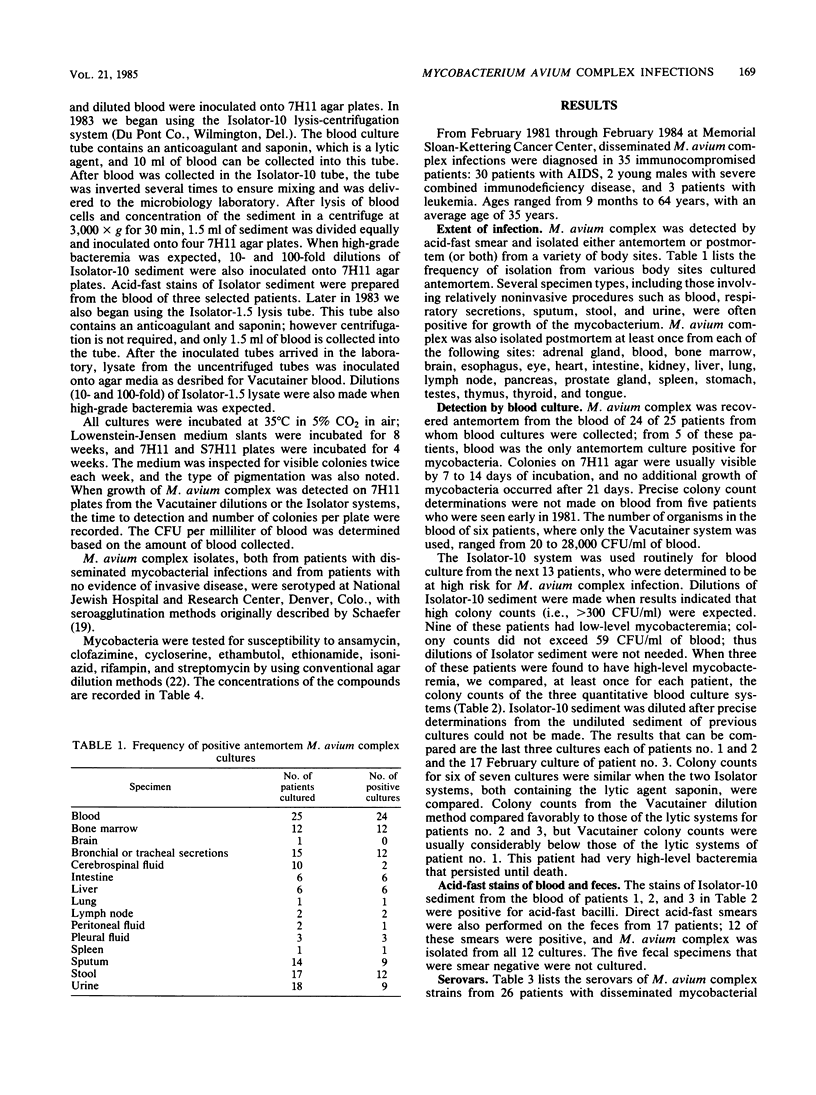
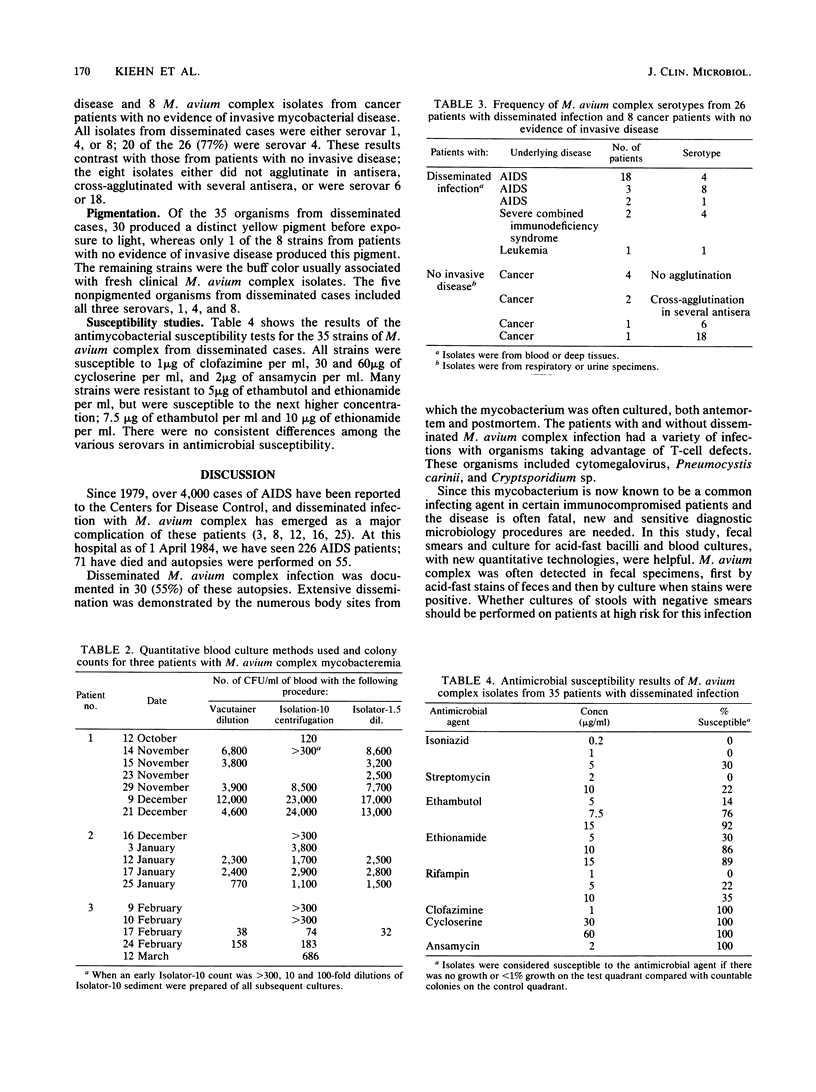
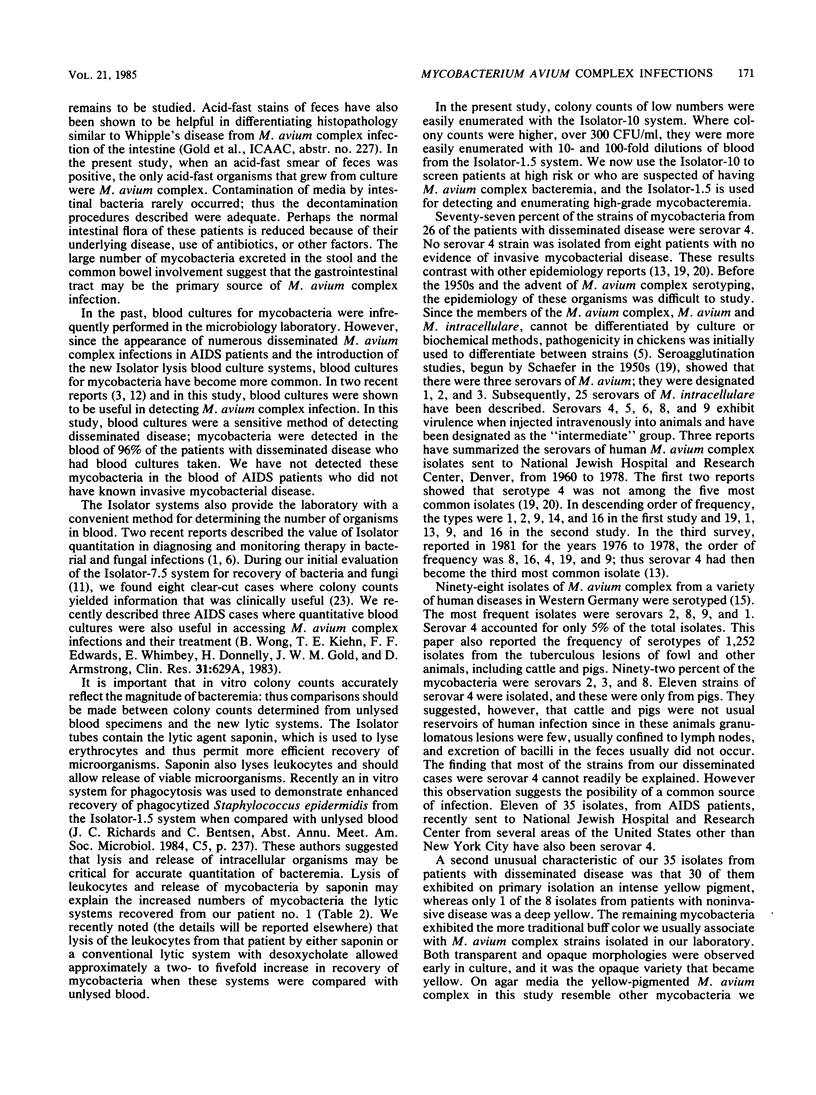
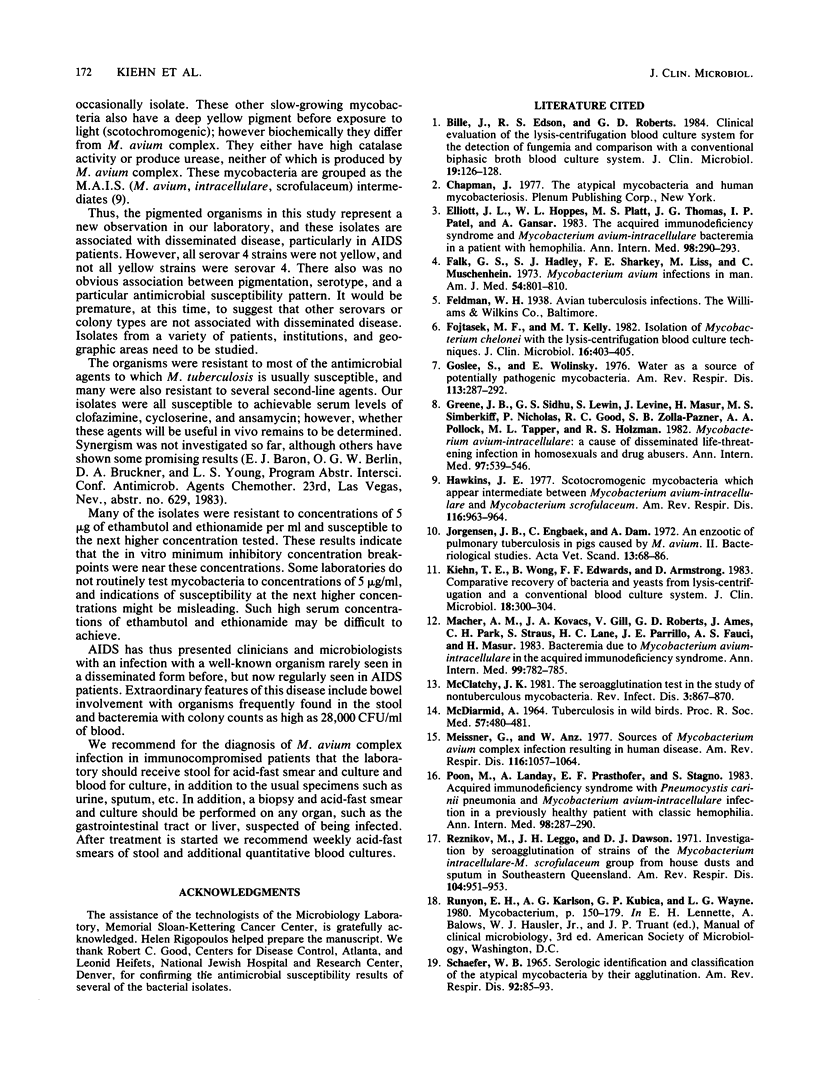
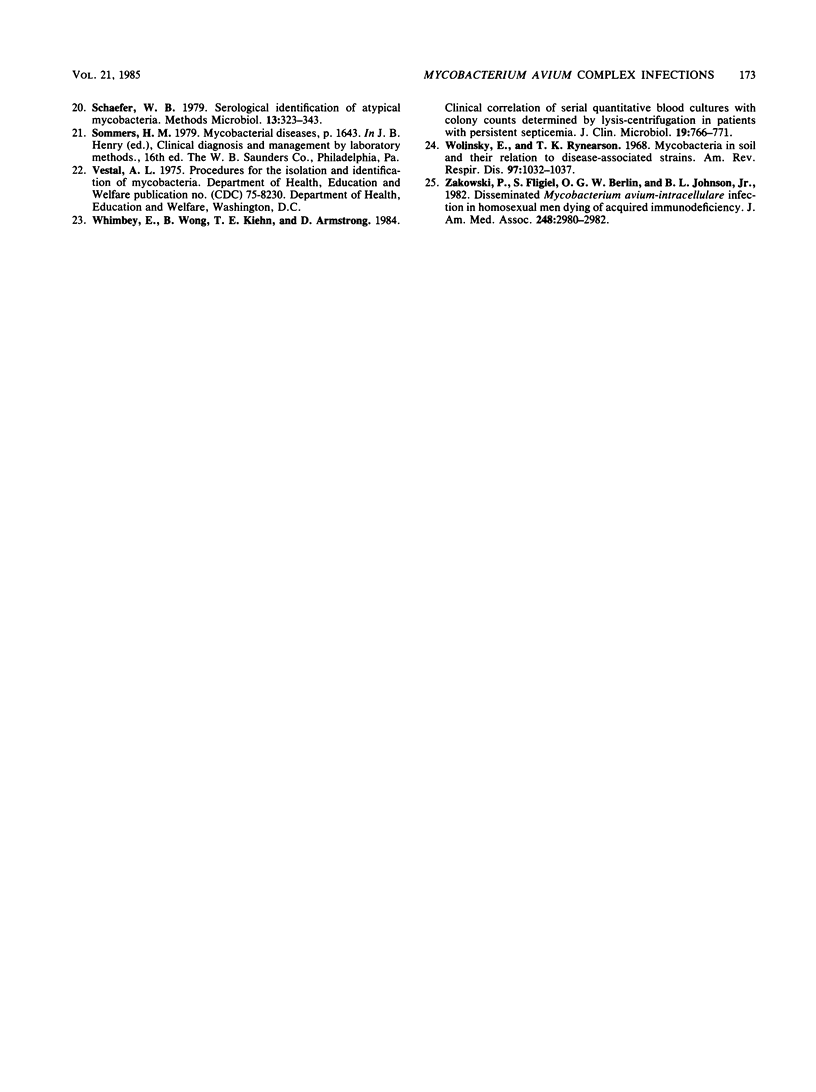
Selected References
These references are in PubMed. This may not be the complete list of references from this article.
- Bille J., Edson R. S., Roberts G. D. Clinical evaluation of the lysis-centrifugation blood culture system for the detection of fungemia and comparison with a conventional biphasic broth blood culture system. J Clin Microbiol. 1984 Feb;19(2):126–128. doi: 10.1128/jcm.19.2.126-128.1984. [DOI] [PMC free article] [PubMed] [Google Scholar]
- Elliott J. L., Hoppes W. L., Platt M. S., Thomas J. G., Patel I. P., Gansar A. The acquired immunodeficiency syndrome and Mycobacterium avium-intracellulare bacteremia in a patient with hemophilia. Ann Intern Med. 1983 Mar;98(3):290–293. doi: 10.7326/0003-4819-98-3-290. [DOI] [PubMed] [Google Scholar]
- Falk G. A., Hadley S. J., Sharkey F. E., Liss M., Muschenheim C. Mycobacterium avium infections in man. Am J Med. 1973 Jun;54(6):801–810. doi: 10.1016/0002-9343(73)90069-7. [DOI] [PubMed] [Google Scholar]
- Fojtasek M. F., Kelly M. T. Isolation of Mycobacterium chelonei with the lysis-centrifugation blood culture technique. J Clin Microbiol. 1982 Aug;16(2):403–405. doi: 10.1128/jcm.16.2.403-405.1982. [DOI] [PMC free article] [PubMed] [Google Scholar]
- Goslee S., Wolinsky E. Water as a source of potentially pathogenic mycobacteria. Am Rev Respir Dis. 1976 Mar;113(3):287–292. doi: 10.1164/arrd.1976.113.3.287. [DOI] [PubMed] [Google Scholar]
- Greene J. B., Sidhu G. S., Lewin S., Levine J. F., Masur H., Simberkoff M. S., Nicholas P., Good R. C., Zolla-Pazner S. B., Pollock A. A. Mycobacterium avium-intracellulare: a cause of disseminated life-threatening infection in homosexuals and drug abusers. Ann Intern Med. 1982 Oct;97(4):539–546. doi: 10.7326/0003-4819-97-4-539. [DOI] [PubMed] [Google Scholar]
- Hawkins J. E. Scotochromogenic mycobacteria which appear intermediate between Mycobacterium avium-intracellulare and Mycobacterium scrofulaceum. Am Rev Respir Dis. 1977 Nov;116(5):963–964. doi: 10.1164/arrd.1977.116.5.963. [DOI] [PubMed] [Google Scholar]
- Jorgensen J. B., Engbaek H. C., Dam A. An enzootic of pulmonary tuberculosis in pigs caused by M. avium. 2. Bacteriological studies. Acta Vet Scand. 1972;13(1):68–86. [PubMed] [Google Scholar]
- Kiehn T. E., Wong B., Edwards F. F., Armstrong D. Comparative recovery of bacteria and yeasts from lysis-centrifugation and a conventional blood culture system. J Clin Microbiol. 1983 Aug;18(2):300–304. doi: 10.1128/jcm.18.2.300-304.1983. [DOI] [PMC free article] [PubMed] [Google Scholar]
- MCDIARMID A. MYCOBACTERIAL DISEASE IN MAN AND ANIMALS. TUBERCULOSIS IN WILD BIRDS. Proc R Soc Med. 1964 Jun;57:480–481. doi: 10.1177/003591576405700616. [DOI] [PMC free article] [PubMed] [Google Scholar]
- Macher A. M., Kovacs J. A., Gill V., Roberts G. D., Ames J., Park C. H., Straus S., Lane H. C., Parrillo J. E., Fauci A. S. Bacteremia due to Mycobacterium avium-intracellulare in the acquired immunodeficiency syndrome. Ann Intern Med. 1983 Dec;99(6):782–785. doi: 10.7326/0003-4819-99-6-782. [DOI] [PubMed] [Google Scholar]
- McClatchy J. K. The seroagglutination test in the study of nontuberculous mycobacteria. Rev Infect Dis. 1981 Sep-Oct;3(5):867–870. doi: 10.1093/clinids/3.5.867. [DOI] [PubMed] [Google Scholar]
- Meissner G., Anz W. Sources of Mycobacterium avium complex infection resulting in human diseases. Am Rev Respir Dis. 1977 Dec;116(6):1057–1064. doi: 10.1164/arrd.1977.116.6.1057. [DOI] [PubMed] [Google Scholar]
- Poon M. C., Landay A., Prasthofer E. F., Stagno S. Acquired immunodeficiency syndrome with Pneumocystis carinii pneumonia and Mycobacterium avium-intracellulare infection in a previously healthy patient with classic hemophilia. Clinical, immunologic, and virologic findings. Ann Intern Med. 1983 Mar;98(3):287–290. doi: 10.7326/0003-4819-98-3-287. [DOI] [PubMed] [Google Scholar]
- Reznikov M., Leggo J. H., Dawson D. J. Investigation by seroagglutination of strains of the Mycobacterium intracellulare-M. scrofulaceum group from house dusts and sputum in Southeastern Queensland. Am Rev Respir Dis. 1971 Dec;104(6):951–953. doi: 10.1164/arrd.1971.104.6.951. [DOI] [PubMed] [Google Scholar]
- Schaefer W. B. Serologic identification and classification of the atypical mycobacteria by their agglutination. Am Rev Respir Dis. 1965 Dec;92(6):85–93. doi: 10.1164/arrd.1965.92.6P2.85. [DOI] [PubMed] [Google Scholar]
- Whimbey E., Wong B., Kiehn T. E., Armstrong D. Clinical correlations of serial quantitative blood cultures determined by lysis-centrifugation in patients with persistent septicemia. J Clin Microbiol. 1984 Jun;19(6):766–771. doi: 10.1128/jcm.19.6.766-771.1984. [DOI] [PMC free article] [PubMed] [Google Scholar]
- Wolinsky E., Rynearson T. K. Mycobacteria in soil and their relation to disease-associated strains. Am Rev Respir Dis. 1968 Jun;97(6):1032–1037. doi: 10.1164/arrd.1968.97.6P1.1032. [DOI] [PubMed] [Google Scholar]
- Zakowski P., Fligiel S., Berlin G. W., Johnson L., Jr Disseminated Mycobacterium avium-intracellulare infection in homosexual men dying of acquired immunodeficiency. JAMA. 1982 Dec 10;248(22):2980–2982. doi: 10.1001/jama.1982.03330220024029. [DOI] [PubMed] [Google Scholar]


